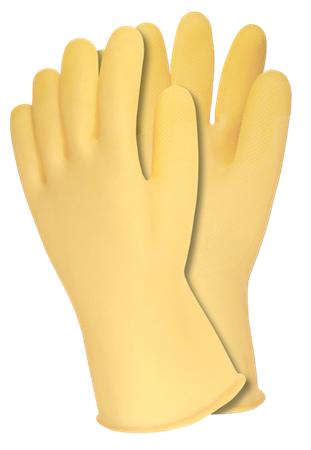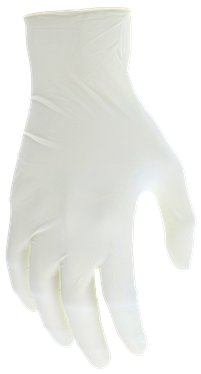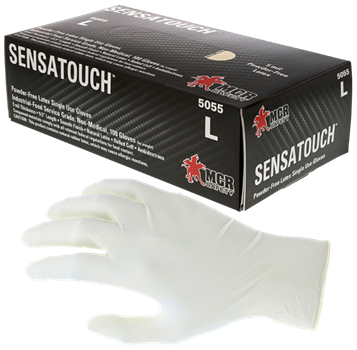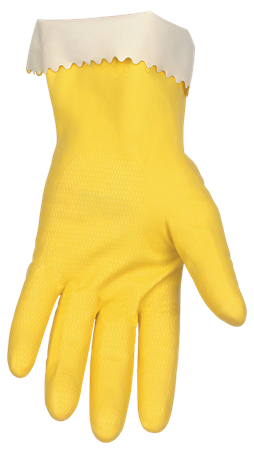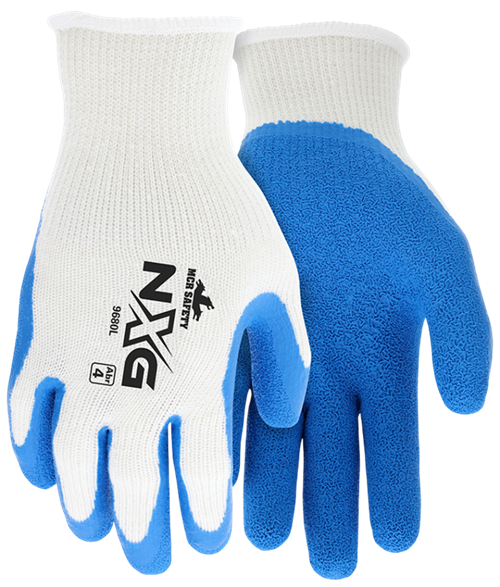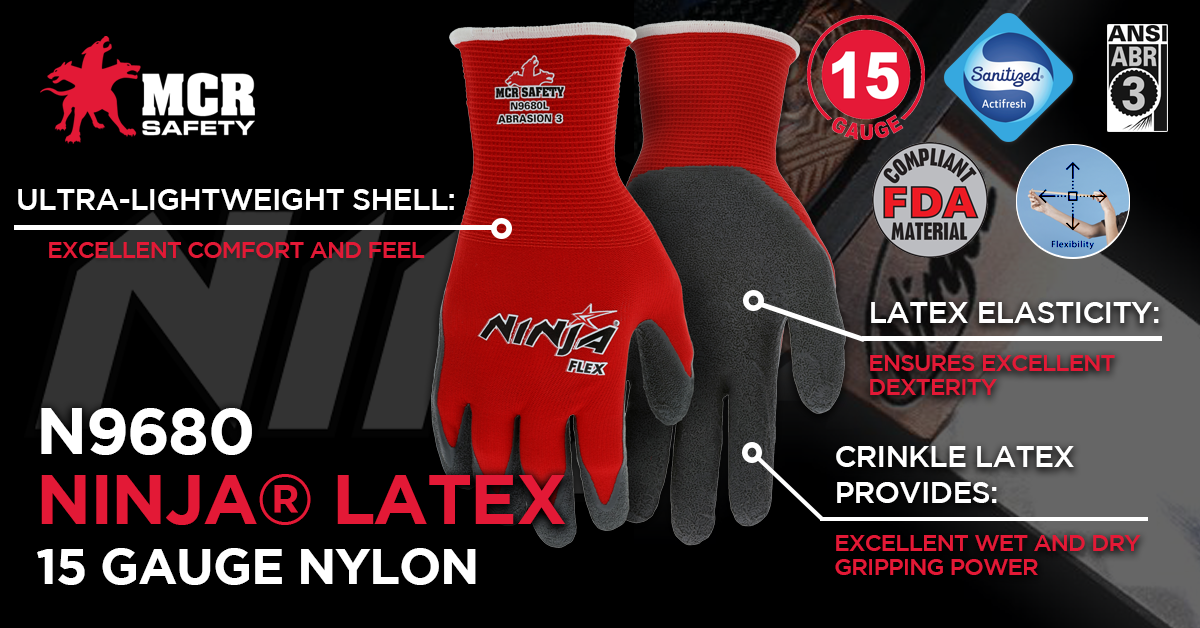29 Oct 10/29/2021
Reviewing Rubber Gloves
When you think of rubber gloves, what comes to mind? Maybe you think of the yellow gloves your grandmother used to wear while washing dishes, or perhaps the latex gloves the nurse wears when you get a shot. You might think of gloves you have worn in the workplace or gloves you put on when cleaning up a horrible mess at home.
People conjure up so many different images when they think about rubber gloves because the category of “rubber glove” actually covers a lot of different products! Gloves, bracelets, bullets, flooring, tires, and wedding rings, are just a handful of the many products you will find made of rubber.
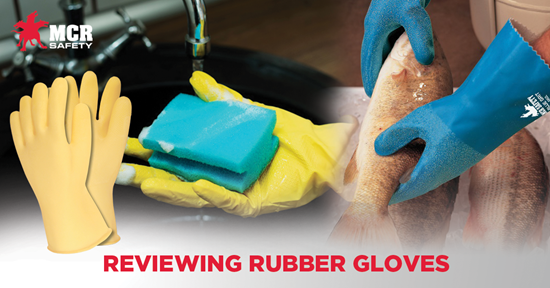
In this article, we’re going to highlight the differences between latex and rubber. We’re also going to showcase all the rubber gloves we stock to keep people’s hands free from injury. Rubber gloves are ideal for protecting a wearer’s hands from various risks, including water-based chemicals, temperature burns, and hazardous materials.
Latex vs. Rubber

Across the glove world, there is often some confusion around the terms latex and rubber. While they both serve to protect the wearer’s hands, there are some crucial differences in the material and the intended use of these two different forms of PPE. Although the words are used interchangeably by many people, understanding the qualities of each will help you choose the right glove for your application. Here’s a brief explanation of each:
- Latex - Sourced from the Hevea brasiliensis, latex is the milky white sap that flows from beneath the bark of a rubber tree. The term “latex” typically refers to the liquid form of this chemical compound. It is a blend of proteins, starches, sugars, resins, oils, tannins, alkaloids, and gums. When it is exposed to air, it thickens and forms a white sap. Latex may be naturally harvested from trees, or it may be synthetically manufactured in a laboratory.
- Rubber – Often referring to a finished product made from liquid latex, rubber is widely used in various products. Some of the most recognized rubber products are household gloves, surgical equipment, tires, and condoms. Rubber is durable, waterproof, and elastic.
You’ll often see work glove options described as latex gloves, latex rubber gloves, or rubber gloves. Now you know that latex is what creates the rubber gloves.
Household and Industrial Use
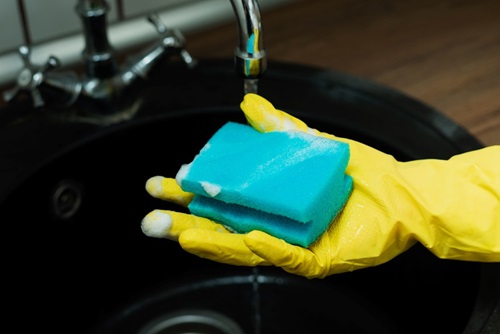
Latex rubber gloves are one of the most common work gloves used worldwide. Due to their elasticity, latex rubber gloves provide one of the most comfortable options available for workers across all industries. Latex disposable gloves are so elastic; people often remark how they feel like a second skin. Their durability means they also stand up well when pulling and grabbing objects.
Hazards in both the home and the workplace can affect people’s hands, but wearing latex gloves can help protect against many of these hazards. Let’s take a look at some places where rubber gloves come in handy.
Household

Washing dishes, cleaning toilets, and sanitizing showers are the household chores where latex rubber gloves are most commonly found. These activities can be demanding on your skin! Cracked knuckles, split fingertips, and dry and chapped skin are just some of the issues that can arise from regularly washing dishes in hot water, especially for anyone with sensitive skin! This is why many dishwashers prefer to wear gloves for this task. MCR Safety’s dishwashing gloves are strong enough to stand up to industrial use but comfortable enough to be worn for household use. Here are some other household activities where a pair of rubber gloves can come in handy:
- Art projects
- Gardening and landscaping
- Painting
- Pet care
- Poison ivy removal
- Pool maintenance
- Washing the car
It is wise for everyone to keep disposable rubber gloves in their homes just in case. For example, when someone is sick or injured, there may be vomit, blood, or other bodily fluids that need to be cleaned up, and rubber gloves can help keep you protected from the mess.
Industrial
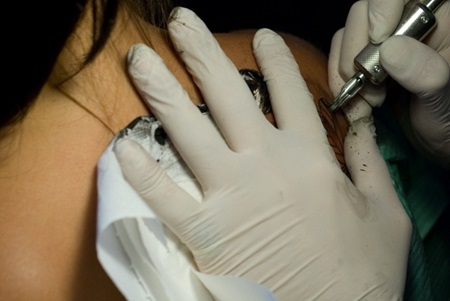
Industrial environments are known for messy work areas, including ink, dust, or other grimy substances. MCR Safety’s latex disposable gloves, along with our thicker reusable styles, keep workers protected from a wide range of workplace hazards. Industrial applications include:
- Automotive – mechanics working with dirty, greasy, or oily parts wear gloves to help keep their hands clean and protected and to help them maintain their grip on parts.
- Construction – workers mixing and working with cement or other hazards want to protect their hands.
- Food preparation – cooks and kitchen staff working at restaurants and during food production wear gloves while handling food.
- Healthcare –dentists, EMTs, nurses, and doctors want to protect themselves from patients’ bodily fluids and potential disease exposure
- Law Enforcement – police may wear gloves during investigations to avoid contaminating evidence or to protect against unknown substances.
- Lab work – technicians handling chemicals wear gloves to avoid contamination.
- Machine shops – workers who are cleaning and emptying coolant tanks wear disposable gloves to protect their hands from potentially hazardous liquids
- Manufacturing – workers cleaning equipment and repairing machines need to protect their hands from job hazards.
- Salon and spa settings – stylists need to protect their hands from dyes while coloring hair.
- Tattooing – tattoo artists wear gloves when tattooing their creative ink designs on clients.
In addition to latex being extremely elastic, it is also relatively less expensive than most other polymers. For companies trying to keep costs down, latex rubber gloves are an ideal glove choice. However, it is essential to remember that latex gloves perform poorly against non-organic greases and oils. They also have limited chemical protection, primarily only offering protection from organic substances.
Now, let’s cover the rubber gloves we offer.
Heavy Duty
Heavy-duty gloves, such as MCR Safety’s 5550 model, are strong enough to withstand extensive use in the workplace or home. At 50 mils thick, the 5550 is the thickest rubber glove in our lineup. If you thought this was some thin glove like you’ve seen in stores, think again. Our users wear this glove for everything from canning food to handling hot glue guns. They have significant gripping power so that you can perform rigorous tasks while wearing them.
We also carry the 6850 and 6852 styles, featuring textured latex rubber and a comfortable interlock lining.
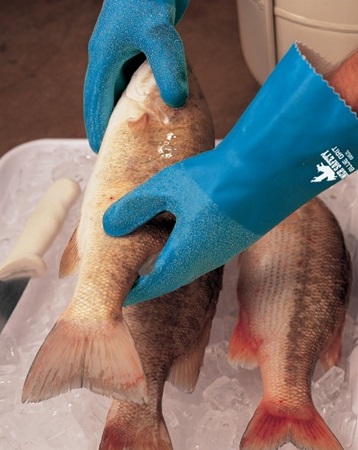
Disposable
Disposable rubber gloves come in handy in so many applications! These super thin gloves are the go-to option for those seeking comfort when needing to avoid hazardous materials and avoid spreading germs.
MCR Safety’s SensaTough disposable latex gloves are powder-free, food service-grade industrial gloves measuring 9.5 inches long and 5 mil thickness. They make kitchen jobs easier while keeping you safe!
Yellow Styles
If you’re looking for that classic yellow rubber glove, look no further than our long flock-lined latex rubber gloves! Don’t get sweaty hands wearing a pair of unlined gloves — use these instead! For those seeking a thicker option, the image below highlights all the flock-lined styles in our lineup.
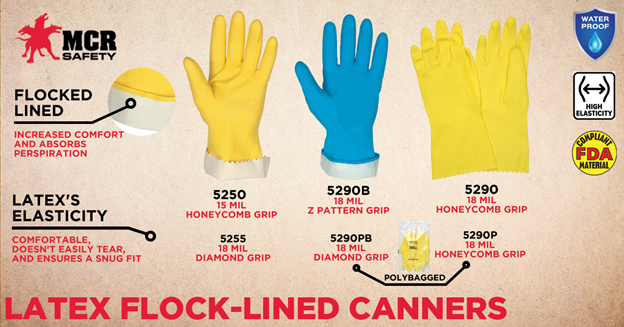
With a 12-inch cuff, these are known as long rubber gloves.
Component materials in our yellow latex gloves comply with all federal regulations for food contact, making them ideal for food preparation activities.
Blue Styles
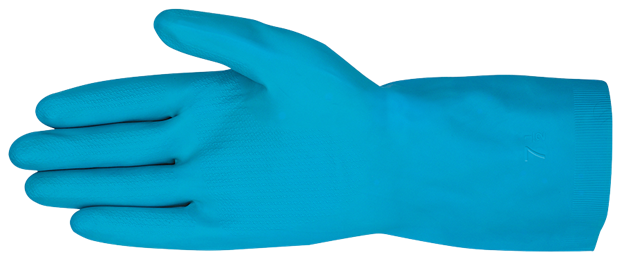
We also offer three blue styles of latex rubber gloves: long blue latex gloves that are perfect for the food industry, disposable medical-grade latex gloves, and rubber-coated work gloves for extra durability and grip.
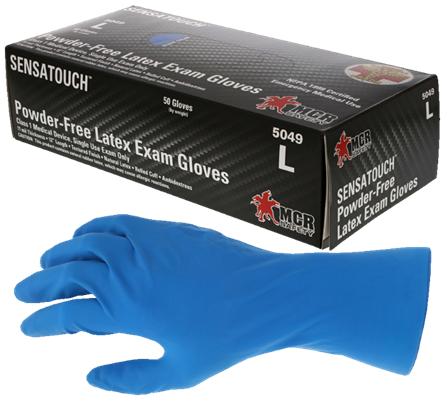
5049 Medical Grade 15 Mil Blue Latex Disposable Glove
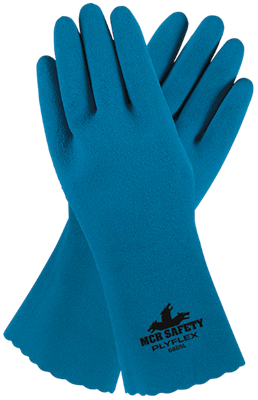
The fully coated textured latex featured on our 6885 style provides exceptional grip. It’s also the ideal glove for those concerned with hot water hazards when washing dishes.
Rubber-Coated
The ergonomic design of our palm-coated rubber gloves reduces hand fatigue, one of the primary reasons people like wearing this style of hand protection. With their rugged textured grip, rubber-coated gloves also provide excellent dry and wet grip. Since workers in the construction industry spend a lot of time operating in wet weather, the industry consumes many rubber-coated gloves. All our palm-dipped options are shown below.

Textured Rubber Coating
Applications where users find these gloves advantageous:
- Concrete handling
- Demolition work
- Climbing roofs, where traction and grip are needed
- Handling firewood
- Gripping wet materials
- Tree trimming
- Handling boxes
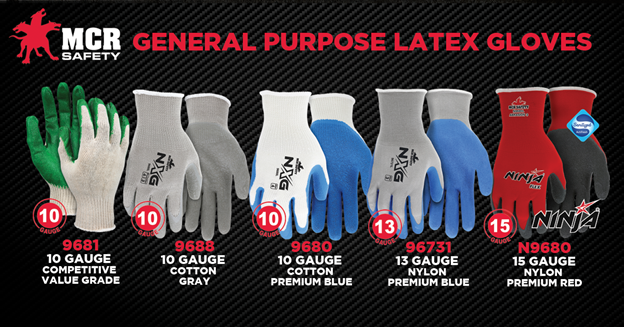
Rubber Coated Work Gloves
The lightest weight option we carry is our 15-gauge N9680.
Our 9680 NXG work gloves have a 10-gauge cotton polyester shell with blue latex palm and fingertips. The 9680 was our number one selling glove for many years and continues to perform well even as more advanced cut shells have entered the marketplace. It provides tried-and-true protection for those who need excellent grip in general-purpose applications. In fact, you’ll often hear users comment how no other glove lasts as long as our rubber-coated gloves!
Insulated
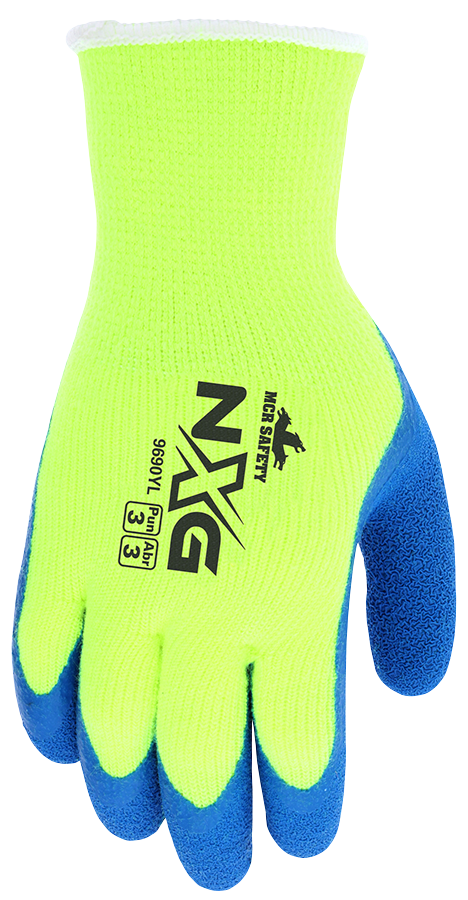
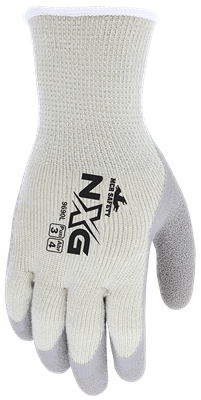
Hi-Vis 9690Y and 9690
Insulated gloves provide extra thermal protection, which is excellent news for those who must endure cold temperatures outside. We stock both a hi-vis insulated rubber glove and a grey insulated rubber glove. Both styles feature a seamless knit liner that is flat dipped to reproduce the natural curved shape of the hand.
Latex Allergy

Some people are sensitive to the latex protein that's contained in natural rubber. As a result of this sensitivity, rubber latex gloves can cause an allergic reaction in people with hypersensitivity to this latex protein. For workplaces where latex allergies are a concern, you’ll need to consider other polymers in our lineup. Nitrile gloves are often considered the next go-to polymer after latex. You’ll lose some of the feel and elasticity of latex gloves by going with nitrile; however, you’ll gain a more rugged glove and protect against latex allergies. Nitrile gloves cost a little more, but if workers are experiencing allergic reactions to latex gloves, these are a good substitute.
Use our online work glove catalog to filter different polymers found across our glove lineup.
Chemical-Resistant
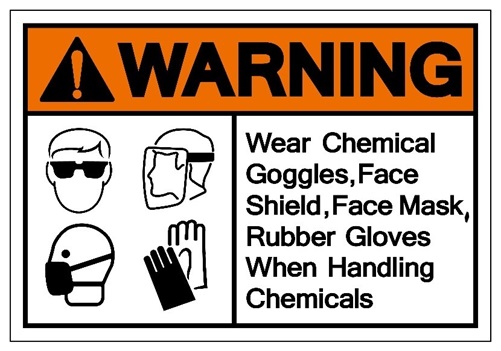
Are rubber gloves chemical-resistant? It depends on the final material composition and construction of the glove. Each rubber glove option offers a different level of chemical protection, which means you’ll need to review our permeation database to find the suitable gloves for your type of chemical exposure.
Common Questions

Where to buy rubber gloves?
- All of our rubber glove products can be purchased via one of our industrial distribution partners. You can request a quote, and we will have your preferred distributor reach out to you. For immediate product trials, visit our Buy and Try site.
How to clean rubber gloves?
- This blog post provides excellent instructions for cleaning your rubber gloves!
What rubber gloves do crab fishermen wear?
- Fishermen need a strong pair of crabbing gloves! Without strong gloves, they have to deal with a long day of discomfort and pain after the crab pinches them. Instead of a rubber glove, we recommend checking out a PVC glove lined with Dupont Kevlar®, like our 6620KV.
How are rubber gloves made?
- Dipping technology is used to make natural rubber gloves. A hand-shaped ceramic or metal mold is dipped into liquid latex and then allowed to dry. Once they are dry, the newly manufactured rubber gloves go through a process of sterilization, leeching, and vulcanization. Vulcanization happens when the gloves are heated to a high temperature to cross-link the various manufacturing chemicals with the latex polymer.
Finally, the gloves are removed from the hand-shaped formers and prepared for shipment.
Do rubber gloves prevent electric shock?
- Insulated rubber gloves prevent the passage of electric current and help protect against electric shock; however, you must purchase a specific type of rubber glove to get this level of protection. At this time, MCR Safety does not stock a rubber insulated glove designed for electrical safety.
Do rubber gloves leave fingerprints?
- Our latex gloves are snug-fitting, which means they are prone to leaving fingerprints. For those concerned with fingerprints, consider using a thicker pair of disposable nitrile gloves.
Can black widow spiders bite through rubber gloves?
- There are varying thicknesses of rubber gloves, as we’ve noted above. For that reason, if there is a concern about poisonous spiders, it’s safer to wear a thick pair of leather gloves.
Can a honey bee sting through a rubber glove?
- The nitrile polymer is three times more puncture-resistant than latex. For that reason, most beekeepers will choose to wear nitrile over rubber gloves.
The Best Rubber Work Gloves
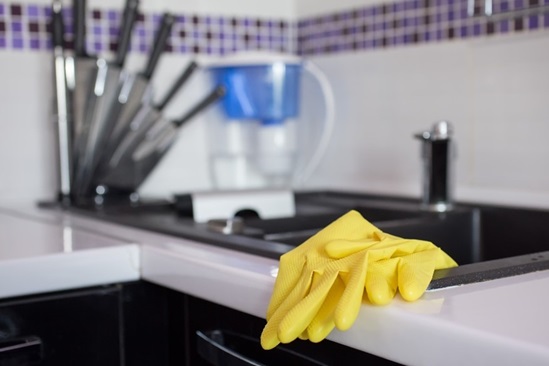
MCS Safety believes in protecting everyone who works in hazardous conditions — whether at home or on the job at medical facilities, construction sites, commercial kitchens, and so much more! The next time your bathroom needs some heavy-duty cleaning, remember that latex rubber gloves are one of the ways that we can keep you safe! These comfortable gloves are highly durable and cost less than most other polymers.
Click the below image to leave us comments, questions, or any concerns.
For over 45 years, MCR Safety has proven to be a world leader in gloves, glasses, and garments. Whether it's working in the kitchen, cleaning the bathroom, building and repairing infrastructure, or at a construction site, we are there providing solutions to workplace hazards. It's all part of our commitment to protect people.
No matter your industry, we have the personal protective equipment you need.

Learn more about MCR Safety by checking out our most recent video. For more information, browse our website, request a catalog, find a distributor, or give us a call at 800-955-6887.
About the Author
Latest Articles





